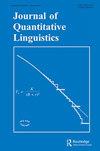Statistical Analysis of the Tables in Mahadevan’s Concordance of the Indus Valley Script
IF 1.7
2区 文学
0 LANGUAGE & LINGUISTICS
引用次数: 0
Abstract
Abstract The Indus Script originates from the culture known as the Indus Valley Civilization, which flourished from approximately 2600 to 1900 bc. Several thousand objects bearing these signs have been found over a wide area of Northern India and Pakistan. In 1977, Iravatham Mahadevan published a concordance of all of the scripts that had been discovered so far. Accompanying the concordance are a set of nine tables showing the distribution of individual signs by position, archaeological site, object type, field symbol (accompanying image), and direction of writing. Analysis of the frequencies of the signs found so far using Large Numbers of Rare Events (LNRE) models estimated the total vocabulary of the language, including signs not yet found, to be about 857. All the tables were analysed using Pearson’s residuals, and it was found that the signs were not randomly distributed, but some showed statistically significant associations with position, object, field symbol or direction of writing. A more detailed analysis of the relation between signs and field symbols was made using correspondence analysis, which showed that certain signs were associated with the unicorn symbol, while others were associated with the gharial and dotted circle symbols.《印度河流域文字玛哈德万汇编》表的统计分析
摘要印度河文字起源于印度河流域文明,该文化繁荣于约公元前2600年至1900年。在印度北部和巴基斯坦的大片地区发现了数千个带有这些标志的物体。1977年,Iravatham Mahadevan出版了迄今为止发现的所有剧本的索引。伴随着一致性的是一组九张表,显示了按位置、考古遗址、物体类型、场地符号(附带图像)和书写方向排列的单个标志的分布。使用大量罕见事件(LNRE)模型对迄今为止发现的迹象的频率进行分析,估计该语言的总词汇(包括尚未发现的迹象)约为857个。使用Pearson残差对所有表格进行了分析,发现这些符号不是随机分布的,但有些符号与位置、对象、场符号或书写方向具有统计学意义。通过对应分析,对符号与场符号之间的关系进行了更详细的分析,结果表明,某些符号与独角兽符号有关,而另一些符号则与gharial和点圆符号有关。
本文章由计算机程序翻译,如有差异,请以英文原文为准。
求助全文
约1分钟内获得全文
求助全文
来源期刊

Journal of Quantitative Linguistics
Multiple-
CiteScore
2.90
自引率
7.10%
发文量
7
期刊介绍:
The Journal of Quantitative Linguistics is an international forum for the publication and discussion of research on the quantitative characteristics of language and text in an exact mathematical form. This approach, which is of growing interest, opens up important and exciting theoretical perspectives, as well as solutions for a wide range of practical problems such as machine learning or statistical parsing, by introducing into linguistics the methods and models of advanced scientific disciplines such as the natural sciences, economics, and psychology.
 求助内容:
求助内容: 应助结果提醒方式:
应助结果提醒方式:


